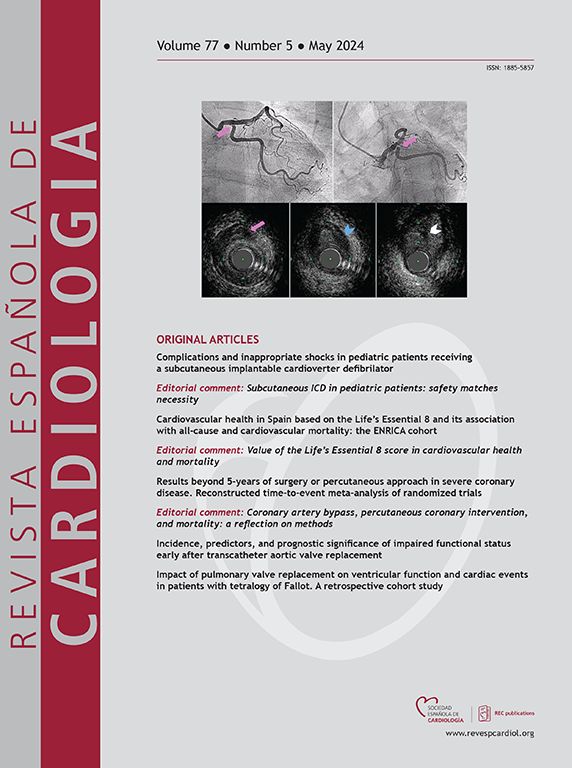IAMCEST稳定患者多酶再循环的时间:系统回顾和网络荟萃分析
IF 5.9
2区 医学
Q2 Medicine
引用次数: 0
摘要
介绍和目的多血管经皮冠状动脉介入治疗(MV-PCI)推荐用于无心源性休克的st段抬高型心肌梗死(STEMI)和多血管冠状动脉疾病(CAD)患者。本网络荟萃分析调查了在这种情况下MV-PCI的最佳时机。方法:我们汇集了随机试验的汇总数据,这些随机试验调查了稳定的STEMI多血管CAD患者,并采用了MV-PCI或罪魁血管仅PCI治疗策略。主要结局是全因死亡。主要次要结局是心血管死亡、心肌梗死和计划外缺血驱动的血运重建术。结果在11项试验中,共有10507例患者被随机分配到MV-PCI组(相同坐姿,n = 1683;指数住院期间分期,n = 3460;在随后的45天内住院期间分期,n = 3275)或仅到罪魁祸首血管PCI (n = 2089)。中位随访时间为18.6个月。与只有罪魁祸首血管的PCI相比,指数住院期间分期的MV-PCI显著降低了全因死亡(风险比,0.73;95%置信区间,0.56 - -0.92;P = 0.008),与所有其他策略相比,它可能是该结果的最佳治疗选择。与只有罪魁祸首血管的PCI相比,MV-PCI降低了心血管死亡率,没有依赖于血运重建时间的差异。在指数住院期间,无论是单次手术还是分期,MV-PCI均可显著减少心肌梗死和计划外缺血驱动的血运重建术,两者之间无显著差异。结论STEMI合并多支CAD无心源性休克的患者,在指数住院期间行多支PCI治疗,无论是单次手术还是分阶段,都是最安全、最有效的方法。不同的多支PCI时间对全因死亡没有显著性差异。本研究注册在普洛斯彼罗(CRD42023457794)。本文章由计算机程序翻译,如有差异,请以英文原文为准。
Tiempos para la revascularización multivaso en pacientes estables con IAMCEST: revisión sistemática y metanálisis en red
Introduction and objectives
Multivessel percutaneous coronary intervention (MV-PCI) is recommended in patients with ST-segment elevation myocardial infarction (STEMI) and multivessel coronary artery disease (CAD) without cardiogenic shock. The present network meta-analysis investigated the optimal timing of MV-PCI in this context.
Methods
We pooled the aggregated data from randomized trials investigating stable STEMI patients with multivessel CAD treated with a strategy of either MV-PCI or culprit vessel-only PCI. The primary outcome was all-cause death. The main secondary outcomes were cardiovascular death, myocardial infarction, and unplanned ischemia-driven revascularization.
Results
Among 11 trials, a total of 10 507 patients were randomly assigned to MV-PCI (same sitting, n = 1683; staged during the index hospitalization, n = 3460; staged during a subsequent hospitalization within 45 days, n = 3275) or to culprit vessel-only PCI (n = 2089). The median follow-up was 18.6 months. In comparison with culprit vessel-only PCI, MV-PCI staged during the index hospitalization significantly reduced all-cause death (risk ratio, 0.73; 95%CI, 0.56-0.92; P = .008) and ranked as possibly the best treatment option for this outcome compared with all other strategies. In comparison with culprit vessel-only PCI, a MV-PCI reduced cardiovascular mortality without differences dependent on the timing of revascularization. MV-PCI within the index hospitalization, either in a single procedure or staged, significantly reduced myocardial infarction and unplanned ischemia-driven revascularization, with no significant difference between each other.
Conclusions
In patients with STEMI and multivessel CAD without cardiogenic shock, multivessel PCI within the index hospitalization, either in a single procedure or staged, represents the safest and most efficacious approach. The different timings of multivessel PCI did not result in any significant differences in all-cause death.
This study is registered at PROSPERO (CRD42023457794).
求助全文
通过发布文献求助,成功后即可免费获取论文全文。
去求助
来源期刊

Revista espanola de cardiologia
医学-心血管系统
CiteScore
4.20
自引率
13.60%
发文量
257
审稿时长
28 days
期刊介绍:
Revista Española de Cardiología, Revista bilingüe científica internacional, dedicada a las enfermedades cardiovasculares, es la publicación oficial de la Sociedad Española de Cardiología.
 求助内容:
求助内容: 应助结果提醒方式:
应助结果提醒方式:


